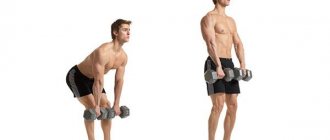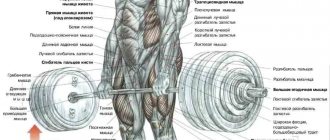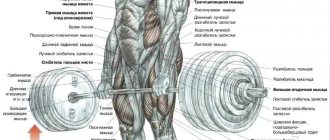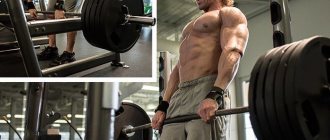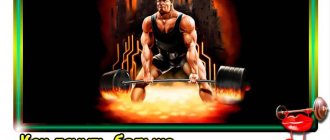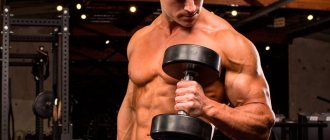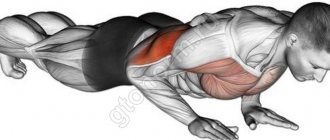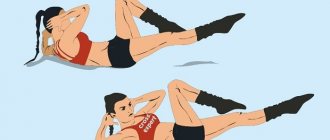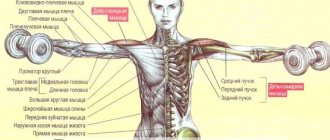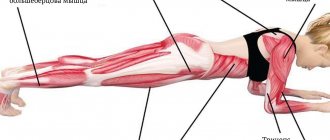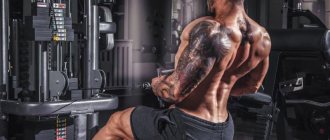The dumbbell deadlift is a great exercise for beginners, athletes recovering from injury, or those who, for example, are cutting and working with light weights. You can also include this exercise in your workout instead of the classic barbell deadlift for variety.
- What muscles work when performing deadlifts with dumbbells?
- Benefits of Dumbbell Deadlifts
- Types of deadlifts and technique, how to do deadlifts with dumbbells correctly
- Classic deadlift with dumbbells for men and girls
- Romanian and deadlift with dumbbells
- Single leg deadlift
- Sumo deadlift with dumbbells
- Recommendations for performing the exercise
Romanian deadlift technique with dumbbells
Take dumbbells in your hands, place your feet parallel to the width of your pelvis. Place the dumbbells on your hips with your arms outstretched, with your palms facing you. As you inhale, move your pelvis back, transferring your body weight to your heels, while slightly bending your legs at the knee joints and stretching your thigh biceps
It is important to keep your back straight by tensing your abdominal muscles. Look straight ahead
The lowest point of the amplitude will be determined by the degree of flexibility of the hamstring biceps, but in no case should you go lower due to rounding the back. The dumbbells should reach approximately mid-calf. As you exhale, straighten your torso by tensing your gluteal muscles and lower back. Push off with your heels and return to the starting position with your back straight.
Single leg deadlift with dumbbells
One cannot ignore another type of deadlift, like the single-leg deadlift with dumbbells. Looking ahead, it should be noted that its benefits are obvious.
This exercise is unusual, rather original, and many have not even heard anything about it, let alone performed it. Its advantages:
- More precise, accentuated work on both the thigh biceps and buttocks and their excellent correction.
- The muscles in these areas become “drier”.
- Improving coordination of movements, vestibular apparatus and plasticity of the athlete.
- Stabilization of the knee joints.
- A significant “blow” to the asymmetry of the gluteal muscles.
- An excellent training opportunity for those people who have back problems. In addition, the exercise partly replaces squats with weights and various leg presses - this is very important for those for whom these exercises are contraindicated.
How to perform and technical details:
- Dumbbells in furry hands near the hips. The starting position is a straight stance with the right leg slightly moved back.
- You need to inhale, and as you exhale, slightly bending your left leg at the knee, at the same time moving your body forward, take your right leg back, thus achieving parallelism of the body with the floor surface.
- Next, you should fixate in the final phase for a couple of seconds, and then exhale and return to the starting position. Do the required number of repetitions, changing the position of your legs.
Clarifications to the above:
- The back is straight all the time, the gaze is only in front of you.
When there is a two-second delay in the final phase, you need to squeeze your gluteal muscles with force.
- The lowering is carried out, if possible, even below the parallelism of the body with the floor surface.
- As you move your free leg back, you need to pull your heel up.
At first, the weight of the burden should be minimal - it is important to master the technique and practice coordination.
We should not forget about correct breathing - effort comes out of it.
The number of approaches is about five, and the repetitions are more than 15.
Muscles involved
The deadlift with a barbell for girls is a basic multifaceted exercise. During its implementation, a large number of small and large muscle groups are involved. The core muscles take an active part in the movement process.
The abdominal press and oblique muscles of the abdomen perform a stabilizing function, supporting the body in a level position. The biceps experience a stretching force when holding a barbell with straight arms. The deltas and forearms are included in the work.
The adductor muscles of the inner thigh are also intensively involved. The trapezius muscles experience static loads, allowing you to maintain correct posture in everyday life. The entire postural chain of the girl’s back body is trained.
advertising is not displayed
However, the main load is distributed between the 3 largest muscle groups:
- Back extensors. These are paired muscles located along the spine in the lower back. They are responsible for maintaining the anatomically correct shape of the lumbar spine. When performing deadlifts on straight legs, these muscles have the heaviest load among all the muscle fibers of the upper body of the exercising girl.
- Gluteal muscles. The gluteus maximus muscle is the main target group for girls performing straight-legged deadlifts. Pulling the pelvis back, during the negative phase of the movement, promotes maximum stretching of this muscle. And the simultaneous use of additional weights contributes to its deep development. When lifting a sports equipment from the bottom point to the starting position, a peak contraction of the buttocks occurs. A similar effect cannot be achieved by any other athletic movement.
Biceps femoris. This is the biceps muscle, which is responsible for bending the leg and bringing the heel towards the buttocks. Developed hamstrings form a clear boundary between the gluteal muscles and the muscles of the legs.
Muscle work in exercise
Regardless of what kind of equipment we take: dumbbells, kettlebell, barbell, deadlift remains the same exercise for the same muscle groups.
Depending on what type of traction we have chosen, the emphasis of the load may shift. Muscle work looks like this:
- Back muscles. For the most part, the load falls on the back extensors, especially on their lumbar part. The lats and trapezius are slightly involved.
- Muscles of the legs and buttocks. These are the quadriceps (they work during the classic deadlift, they are switched off in the deadlift on straight legs, in the Romanian they are minimally involved), the hamstrings (they work everywhere, but most of all in the deadlift), the gluteus maximus muscles (here the leader in load is the Romanian).
- Forearm muscles. They are loaded due to the fact that you are holding the weight with your hands.
Many more muscles are slightly involved. They help the main working groups and stabilize the core.
In other words, in an exercise with dumbbells everything is exactly the same as with a barbell. The projectile is different, but the movement technique is the same.
Execution options
- Row lying on a horizontal bench. The bench is installed on plinths or stops. The athlete fully extends his arms at the elbows and lies face down. This variation shifts the emphasis to the latissimus dorsi muscles and promotes deeper muscle development;
- Wide and narrow grip rows. A wide grip or positioning of dumbbells in this exercise helps to shift the load to the outer fascicles of the lats. Raising the elbows to the sides also includes the rear bundles of deltoid muscles. This creates the T-shaped back shape desired in bodybuilding;
- One arm row. A variation for those who have problems with simultaneous activation of both halves of the back, and who suffer from asymmetric muscle development;
- Bent-over barbell row. A variant of a more powerful format, promotes the development of the skill of balancing a projectile.
Alexander Shchukin. Dumbbell rows on an incline bench. Dumbbell rows with chest resting on an incline bench
Watch this video on YouTube
Romanian dumbbell row
- We get into the starting position with slightly bent knees. We hold dumbbells with a straight grip, palms facing our feet. You can turn them a little so that the dumbbell does not walk strictly along the front, but partially along the side surface of the thigh. Apart from the knees, the starting position is exactly the same as in the previous case.
- We bend the torso forward. The dumbbells are directed towards the feet. In this exercise, the pelvis goes back by bending the knees. This is why you don’t need to have a good stretch, since you don’t need to stretch with straight legs.
- Lower the dumbbells to the lowest possible point so that they slide along your legs.
- We return to the original state, the pelvis moves slightly forward. At this moment, you should tighten your buttocks as much as possible and squeeze your shoulder blades together. This is the completion of straightening. We lift as we exhale, and lower as we inhale.
https://youtube.com/watch?v=BJw0GXauTXc
We make all movements smoothly and thoughtfully. It is advisable to have a mirror in front of you. You will just keep your head level while observing yourself.
Tips for maximum efficiency
- Before you start deadlifting on straight legs, do a set of stretching exercises.
- Do 1-2 warm-up approaches before the main ones. This will warm up the muscles and prevent injury.
- If you find it difficult to hold the barbell in your hands throughout the exercise. You can use special wrist straps. They will take the stress off your wrists. And you can calmly concentrate your attention on the work of the target muscles.
- Regarding the use of an athletic belt. It won’t help in any way with deadlift. Since we do not need to create additional intra-abdominal pressure. And in general, if the technique is incorrect, using a belt is useless. So work on it.
- In order to feel the muscles of the back of the thigh even better, you can use the pre-exhaustion method. That is, first we do LYING BENDS in the machine, and then immediately deadlifts. And so on every approach. It is worth considering that the working weight will be less.
- The exercise is best performed in the medium rep range. Approximately 10-15 repetitions. This way you can concentrate on working the right muscles. And don't overload your lower back.
- The position of the feet also plays an important role. If they are spaced apart, the hamstrings will receive more load. Turning them in the direction of each other will shift the emphasis to the semitransverse muscle.
That is, if you consolidate all of the above. This can be concluded. The stiff-legged deadlift is one of the best exercises for targeting the hamstrings. To get good results, you should concentrate on the execution technique. Work it out to the smallest detail, and then the risk of injury for you will be zero.
Good luck to everyone in your training!
Recommendations
- The bar should be non-slippery, ideally competitive. If there is none in the hall, use straps;
- You should wrap your back in the same way as you would for a regular competition deadlift;
- The weak point of this row is the need to pull the weight from a point that is lower than usual, therefore a significant risk of rounding the back accompanies the exercise;
- It is not worth “inserting” the thoracic region rigidly because its deflection in the opposite direction leads to overload of the lower back and injury;
- The lumbar region should be rigid in the deadlift. The chest can just be slightly bent, creating the effect of a fishing rod;
- The shoulders calmly move forward and drop slightly.
The benefits and disadvantages of the Romanian dumbbell deadlift
Pros of exercise
- The target muscles of the exercise are the muscles of the back surface of the body, namely the hamstrings, gluteal, and lumbar extensors. This option allows you not only to make the muscle relief more defined, but also to strengthen the muscles that stabilize the spine, necessary in other complex basic exercises, such as squats or deadlifts. Strengthening your back muscles helps maintain a healthy spine and prevents injuries.
- The dumbbell option can be performed with either heavy or light weight, depending on your goals and preparation. For example, dumbbell deadlifts are more commonly used by men as a barbell replacement for instability when performing dumbbell deadlifts. This imbalance allows you to better concentrate when performing deadlifts on the target muscles and recruit more muscle fibers into the work. Since the option is not as convenient as with a barbell, the body spends more energy and progresses thanks to the new load.
- Girls use it for the same reasons, but also to reduce working weight when the barbell is still too heavy.
Minuses
Disadvantages include the possibility of injury to the hamstring, since shortening, tightness and inelasticity of the hamstring muscles can easily be injured when using a technique with fairly intense muscle traction, especially with heavy weight. Therefore, it is necessary to start the exercise only if you have flexible muscles and ligaments.
Benefits and anatomy of the exercise
The deadlift with dumbbells is considered one of the basic exercises, which, when performed, involves the maximum number of muscles. With its help, the biceps in the hips and back are strengthened, and the quadriceps are involved. The emphasis is on the gluteal muscles and thighs. The rhomboid and latissimus dorsi muscles also work.
A deadlift is performed by vigorously extending the legs and hips. The trapezius muscles are also involved during movements, but they are not the target muscles.
This exercise is in many ways similar to the classic deadlift. At the moment of lowering, there is a stretching of the muscles of the posterior chain. When raised, they contract.
Some of the benefits of deadlifts with dumbbells include:
- suitable for beginners;
- you can practice at home, without special equipment;
- it is possible to correct the technique of classical traction;
- the load is distributed evenly;
- the spine is not overloaded;
- not only muscle tissue is strengthened, but also ligaments;
- promotes grip development.
Exercise also has disadvantages. The main one is the inability to use a lot of weight. For example, when training with a barbell, a constant increase in mass is allowed. In the case of dumbbells, this is not possible. Accordingly, a power variant with several repetitions can only be performed with a barbell.
Rounding the back
An error occurs if the athlete chose the wrong set of dumbbells, that is, did not calculate the weight. Or he simply doesn’t have the right technique.
The whole person rises not on an arched back, but “on his hump”, and accordingly, the spine is loaded. This happens in all deadlift variations.
In addition to the injuries that can occur when performing exercises with a slouched back, the effectiveness is lost by more than half.
This often happens on the first rep, meaning the athlete lifts the weight off the floor in a hunched position and then straightens up. It is recommended that when lifting, you look not forward, but a little higher, so that you instinctively have the desire to lift the barbell or dumbbells to the ceiling.
Main mistakes
Beginner athletes often make all sorts of mistakes when performing deadlifts. This leads to the fact that the exercise turns out to be ineffective, and often even leads to injury.
To do deadlifts correctly, you need to avoid these mistakes.
- When performing deadlifts with straight legs, it is important to maintain a slight deflection in the lumbar region, as well as straighten your shoulders, otherwise muscle development will be ineffective and the likelihood of injury will increase.
- The most common mistake is incorrect placement of the legs and changing their position during the deadlift - the knees should remain straight or slightly bent until the end of the exercise, the heels seem to “grow” into the floor, and should never be lifted off.
- The projectile must necessarily fall below the knee joint - the lower you can lower the barbell or dumbbells, the better the result will be.
- Another common mistake made by beginning athletes is using heavy weights, which often leads to incorrect deadlift technique and injuries.
On a note! Experts recommend doing deadlifts with light weights. It is important to concentrate on working the target muscles. As a result, the exercise will bring maximum effectiveness.
Muscles involved
The classic deadlift with dumbbells or barbell is a basic exercise. It is believed that 90-94% of the muscles of the whole body are involved when performing.
The load is static in nature, but you should not detract from the merits of the exercise because of this. As for dynamic, its effect varies depending on the type of exercise.
Classic version
The quadriceps femoris, buttocks and group of spinal extensor muscles (spinous, iliocostal and longissimus) are worked out.
The development of the latter is especially important: inflated “pillars” protect the spine from injuries during stress and lift the latissimus muscles from the inside, visually increasing the width of the athlete’s back
Sumo
First of all, the adductors of the thighs are tensed - they are located on the inner surface of the thigh, forming a layer of tissue responsible for pulling the legs to the middle of the body. Adductors are a group of adductor fibers consisting of the long, brevis, pectineus, gracilis and major muscles.
In addition to the above, the buttocks and quadriceps are loaded. The spinal extensors are less loaded, and the hamstrings are responsible for balancing the body when performing deadlifts.
Romanian deadlift
The technique involves working the buttocks and biceps femoris, which take on the lion's share of the dynamic load. Unlike the above methods, the quadriceps is not involved.
In any technique, balance is maintained by tightening the calf muscles, abdominal muscles and upper back (trapezius, lats and rhomboids).
Nuances when performing
The main rules that should be considered when performing deadlifts on straight legs:
- Under no circumstances should you round your back! In this position, your technique will be severely impaired, causing your back to receive most of the load, while the leg muscles will be practically unused. In addition, the likelihood of injury with a rounded back is incredibly high!
- You don’t need to keep your legs perfectly straight, but you shouldn’t bend them too much either. In the first case, you can be seriously injured, and in the second, the main load will fall not on the back of the thigh, but on the front.
- Try to keep the projectiles along your legs and as close to them as possible. This way you will set the correct load vector and better work the gluteal muscles with the hamstrings. The option of holding dumbbells in front of you will not be effective and will completely defeat the purpose of performing this exercise.
The benefits of deadlifts
Why do you need a deadlift if you have a classic one? This is one of the frequent and common questions. The fact is that many people have hamstrings that are not as well developed as quadriceps. And isolated exercises are not always effective for its growth.
Some people mistakenly believe that exercise is only useful for the fair sex. However, in fact this is not the case. It all depends on the goals and objectives that determine the number of approaches and repetitions.
The exercise can be both strength training and good endurance training. Thanks to this, it will be useful for those who engage in martial arts, running, jumping, athletics and other sports where most of the load falls on the legs.
For protrusion, problems with knee and hip joints, the exercise is not recommended! The best solution would be isolated and restorative exercises for the entire muscular corset of the lumbar spine.
Varieties
There are different types of this exercise. Each of them has a number of distinctive features. To choose the most suitable option for yourself, the exercises should be considered in more detail.
Classical
In the classic version, deadlifts with a barbell allow you to develop back muscle tissue. The exercise is performed on bent, but very slightly, legs. You need to adhere to the following scheme:
- The body initially straightens, after which the back bends slightly.
- The chest is pushed forward.
- The shoulders move back.
- Feet are shoulder-width apart.
- The buttocks and hips move back slightly so that the bar falls without jerking or sudden movements.
- Along with the lowering of the projectile, the pelvis moves back.
- When raising the bar and lowering it, the lower back remains arched all the time.
- The bar must be lowered to the floor. After this, it is raised again, making a short delay at the level of the knees.
Speaking about how to do this exercise correctly, special attention should be paid to the grip. It is performed shoulder width apart. The palms should be directed towards the body.
Romanian
The Romanian deadlift, performed with dumbbells, is so named thanks to the efforts of weightlifters from this country. With the help of this exercise, they won many victories, participating in competitions on an international scale. In fact, this is a derivative of the classic version, in which an isolated load is placed on the gluteal and femoral muscle tissue.
The training scheme is identical. True, the shells do not fall to the floor. The lowest point is the level of the center of the shin. This reduces the load on the lumbar region. The risk of injury to the spine is minimized.
On the Smith machine
The exercise is considered an excellent option for beginners. When performed on a Smith machine, deadlifts are several times safer than the classic version. The design of sports equipment consists of several securely fixed elements. The machine is equipped with hooks that allow you to hone your technique before moving on to working with free weights. The risk of back strain and injury is minimal.
To perform this exercise correctly, you need to constantly monitor your back. It should be smooth and in tension. Relaxation of muscle tissue is unacceptable.
With dumbbells
The deadlift technique with dumbbells is no different from the Romanian one. The only difference is the use of different equipment. During training, the athlete pumps up muscles using dumbbells rather than a bar.
It is extremely important to adhere to breathing rules when performing the exercise . When the shells fall to the floor, you need to take a deep breath. Deadlifts are done with dumbbells on straight legs. They bend slightly only when the equipment is taken and when the bottom point is reached.
Such exercises with dumbbells for girls are considered an excellent option. When they are performed, the gluteal muscles are pumped up. The figure acquires a sporty, beautiful appearance.
What muscles work when performing the exercise?
Most of the work is done by:
- Lumbar - they lift and return the body to its original position.
- The muscles of the buttocks and biceps of the thigh - when performed, they stretch well, which allows them to be given an excellent load. Synergistically interacting with the lumbar region, they provide the push necessary to lift the body.
In addition to them, the following are used:
- Core muscles - help to hold the barbell without changing the position of the body.
- The muscles of the forearms, shoulders and trapezius are needed to hold and fix the barbell.
- The calf and ankle stabilizer muscles provide a stable position.
In fact, we could go on and on about which muscles work during a deadlift. Since it is a subtype of the classic deadlift, it includes the combined action of many muscle groups, large and small. By interacting and complementing each other’s work, they turn the deadlift into one movement that develops the entire body.
Differences between types of traction
There are several types of deadlifts that are similar in execution technique (dead deadlift, Romanian deadlift, classic deadlift). However, there are still differences between them, due to which these exercises are easy to confuse.
The Romanian deadlift differs from the deadlift in the following ways:
- The legs are bent at the knees - a lower inclination makes the angle of bend of the legs greater, it is enough that it is no more than 15 degrees.
- During the movement, the pelvis moves back - unlike a deadlift with straight legs, where the body bends, in the Romanian deadlift it is the pelvis that takes the main load, which goes back, as a result of which the back bends.
- When lowering, the bar does not reach the middle of the shin - it is enough for it to drop just below the knees, since it is quite difficult to keep your back straight during further movement.
- Since the Romanian deadlift allows for bending of the knees, the athlete's stretching does not play such a significant role in this case.
- In the Romanian deadlift, the greatest load is placed on the muscles of the buttocks - when the athlete returns to the starting position, the gluteal muscles are strongly compressed and the pelvis moves forward.
For reference! It is important to note that deadlifts and Romanian deadlifts are considered the most suitable exercises for women.
The differences between classical and Romanian deadlifts are as follows:
- In the Romanian deadlift, lifting is not done through the work of the legs, and the knees are bent solely so that the athlete’s flexibility does not interfere with the correct technique of the exercise.
- In the deadlift, the squat is done in order to transfer the load to the legs and back, due to which these muscles work at the stage of lowering and lifting the projectile (due to such features, the deadlift requires more weight on the lift).
For reference! The classic deadlift is most suitable for men. Girls should prefer it only if they need to significantly increase their strength.
The differences between classic and deadlifts are obvious.
- They consist in the position of the legs when performing exercises. If in the deadlift the knees are straight or slightly bent, then in the deadlift they can bend at a greater angle.
- Classic deadlift involves not only bending the legs, but also squatting to an incomplete amplitude. When performing a deadlift, although the legs are straight, the knees should be relaxed rather than held in a locked position. Thus, the formation of an angle of up to 2 degrees is allowed, which is quite difficult to visually recognize.
Before you start performing classic deadlifts, it is advisable to train for some time with simpler exercises to strengthen your back muscles and prepare them for the load. It is also important to do stretching for about a month. If for some reason it is not given, you can prefer the Romanian deadlift. It is considered more gentle.
If deadlifts with straight legs are painful, this exercise can be replaced with another one, which also helps to work the back of the hips. For example, leg press for hamstrings, leg extension in a machine, leg abduction with weights, etc.
Safety regulations
- Back hurts during and after exercise. You need to do hyperextensions without weights for one month to strengthen your lower back. At the same time, stretch your muscles so that your technique does not suffer from lack of stretching. Before the exercise, you can smear your back with warming ointments, you can also use painkillers. The main principle is do no harm! If the pain remains after a month of hyperextension, you should see a specialist.
- My knees hurt. It's difficult to offer anything here. Try wrapping elastic bandages around your knees. Sometimes this option helps. Sometimes not. Go to a specialist and find out if you have flat feet. If you have them, order special insoles and place them in your shoes for the gym.
- You feel dizzy when you bend over. Contact a neurologist. This shouldn’t happen (unless you are 60 years old, of course – these are age-related characteristics of the body).
Technique for performing deadlifts with dumbbells
The exercise can be classified as an average level of difficulty
It is very important that at first a coach or an experienced friend helps you control the deadlift technique with dumbbells.
This will eliminate possible errors and omissions, which will increase the effectiveness of the exercise. Let's take a closer look at how to do it correctly:
- Starting position: select dumbbells of suitable weight, take them in your hands and lower them at hip level. Feet shoulder-width apart, feet parallel to each other. The back is straight, with a natural arch in the lower back, the shoulder blades are slightly brought together, the gaze is directed straight. It is allowed to slightly bend your knees and fix them in this position.
- While inhaling: we smoothly lower ourselves down by moving the pelvis back and bending our legs at the hip joints, while holding the dumbbells in front of us, smoothly moving them along the thigh so that they are parallel to it. During the movement, the back is straight, the shoulder blades are brought together. Lower yourself until you feel a stretch in your hamstrings.
- As you exhale: smoothly return to the starting position, straightening your torso and straightening your hip joint.
What weight of dumbbells - everyone selects individually, depending on physical fitness and capabilities. It is better to start with a small weight and gradually increase it.
Dumbbell deadlifts can be included in your training program on both leg and back day. It’s better to have a trainer help you get used to the technique.
Correct technique is the key to success and safety of training
Correct technique:
- The starting position is that the legs are not very wide apart, but the feet are parallel to each other.
- The grip width is chosen slightly larger than the width of your own pelvis.
- The feet are positioned under the barbell so that the shins touch it.
- The pelvic part is retracted back to the maximum, while the back remains straight and the shoulder blades are brought together.
- You need to bend your knees slightly to relieve tension from them, but you absolutely cannot bend your knee joints inward.
- The barbell must be lifted smoothly, without jerking or sudden movements. Look straight ahead.
- The weight is placed near the shins, and when the upper phase is reached, the body must be fixed in a strictly straight position, and the knees must be straightened. It is not permissible to tilt the body back to avoid overloading the lumbar region.
- The barbell should be lowered while simultaneously tilting the body forward and bending the knees. Everything is done in the reverse order with the same precision as when lifting.
You need to ensure proper breathing - this is a very important aspect. Exhalation occurs during the hardest part of the exercise, that is, during the ascent, and when the projectile moves down, the breath is held, while inhalation is performed in the upper phase of the exercise.
Execution technique
Initial position
- The first option is to take an inclined bench, and the athlete sits on it with his stomach, while the backrest is 30-45 degrees;
- The second is a straight bench, but it is placed on stacks of plates or plinths to ensure a comfortable high position;
- After the bench is installed, a barbell of adequate weight is assembled. This exercise cannot be done with the same weight as a regular bent-over row; you need to reduce it by 30-50 percent;
- The athlete lies on the bench with his stomach and takes the barbell with a medium grip;
- You can use an assistant if the bench is too high;
- Then it remains to tense your abs and rest your feet on the floor for better fixation.
Movement
- Begin to pull your shoulder blades toward your spine and tense your back;
- As soon as the bar moves up about a third of the trajectory due to the work of the back, simply bring it with your hands to the support;
- Hold for a few seconds at the top and lower down 3-5 counts;
- Complete all reps as planned.
bodymaster: Bent row
Watch this video on YouTube
Recommendations
- You can use straps if the projectile is difficult to hold;
- A slight elevation of the head is allowed, but not flexion of the spine in the cervical region.
Mistakes when doing dumbbell rows
- Dumbbells dangle from side to side. You create unnecessary stress on the muscles that provide your balance and overload your lower back.
- Fast execution. Every movement should be smooth and clear.
- Breathing disorders: we go down as we inhale, we rise as we exhale. You can remember this: we exhale for effort, and effort is made when we lift something from the floor. Usually this phrase helps you remember correct breathing during exercise.
- Round back. Even with such weights, you can round your back if you do not have good stretching, and even if you are not on straight legs.
- With the classics, we first pull with the lower back, and then straighten the body. There should be a clear algorithm - legs, then lower back. And nothing else. We lift the weight off the floor with our feet, then smoothly switch to the lower back.
- We do not bend at the end point. Such a repetition may not be counted. This is not done to pump up the latissimus muscles, but to completely straighten the back.
- Look down during the exercise. This is a serious violation of any deadlift technique.
Deadlift with wide stance
Now we will talk about deadlifts with wide stance - the sumo system. The sumo style requires some preparation, since stretching is very important here, without which you should not start training.
It is better to grip the bar with a different grip, since it is the safest and most correct - this way it is easier to maintain the maximum weights.
It’s worth mentioning right away: this technique is suitable for competitions. It is better to train using a direct grip.
Equipment is very important, in particular shoes - they should have flat and hard soles that do not spring.
You should not exercise without an athletic belt, especially if you have back problems - this will save the athlete from unnecessary problems.
With the help of sumo deadlifts, maximum weights are lifted, and to achieve this goal, you need to work as many muscles as possible and reduce the amplitude of this exercise to a minimum. This is why the wide stance of the legs is used.
What muscles work?
- Legs, buttocks - quadriceps, hamstrings, adductors, gluteal muscles (major). This area is subject to much greater load than in the classics.
- Back – latissimus muscles, extensors. Here the load is inferior to the classic version of traction.
- Forearms.
The technique of performing the sumo system must be observed impeccably and mastered with small weights. This deadlift is performed either in Smith, or from the floor, or from an elevated position. Advantages of running in Smith:
- The weight can be taken from any point that is convenient.
- The trajectory of the weight is strictly vertical, without deviation, and this makes it possible to set greater isolation on certain muscles without wasting energy on stabilization.
However, if the goal of the training is powerlifting, then it is better to train with a free barbell.
Lifting the barbell from the floor:
- Starting position – feet wider than shoulders.
- The pelvic part is retracted back, the back is only straight, and there is some minimal deflection in the lower back.
- The head position is either straight or slightly higher - it is advisable to look in the mirror.
- The toes of the feet are turned outward at 45 degrees, as are the knees.
- The arms are pubescent, relaxed, and the bar is located near the feet.
- You need to reach for it only through the movement of your legs - a deep squat is done, allowing you to reach the floor with your hands, and the body bends quite a bit.
- The bar should be taken with a relatively narrow grip, but so that you can maintain balance.
Lifting is carried out using the strength of the legs. In the upper phase, when the legs are straightened, the body is straightened, and the shoulder blades are brought together.
The final movement will engage the latissimus muscles.
All movements are smooth and without jerking.
Contraindications
There are no ideally healthy people, so if you have back problems, doing the exercise incorrectly can lead to pain and injury. Beginners often sin by chasing more weight when the body has not yet had time to get used to it. In this regard, performing deadlifts at the expense of technique can be harmful to health.
For example, people often slouch or round their lower back at the lowest point of amplitude
The load on the spine increases many times over, so the exercise is recommended to be done with extreme caution in case of the following problems:
- scoliosis;
- knee joint injuries;
- lordosis;
- varicose veins;
- excessive kyphosis;
- rachiocampsis;
- protrusion in the lumbar spine;
- hernia of the spinal column.
If you have a strong desire to exercise despite illness, it is better to first consult with your doctor.
Methods of execution
Deadlifts can be performed in different ways, depending on whether the leg or back muscles do the main work.
There are the following ways to perform deadlifts:
- with a barbell;
- with dumbbells.
In addition, when performing the exercise, you can use several coverage options:
- back;
- straight;
- multidirectional (otherwise called multi-grip).
Barbell deadlift
This method of deadlift is considered by many athletes as the main one. The exercise is performed with a barbell and provides a significant load on the back muscles, but only when the equipment is lowered while moving the bar along the legs. If it is not brought out in front of you, the muscles of the buttocks, as well as the biceps of the thighs, are directly involved in the work.
Deadlift with dumbbells
The deadlift with dumbbells has an undeniable advantage over the barbell exercise. When doing this, the brushes are placed more naturally. Thus, additional stress on the joints and muscles of the hands is eliminated. This deadlift is especially suitable for athletes who have had arm injuries in the past. Sometimes it is the only possible way for them to complete the exercise.
The dumbbell row puts more stress on your hamstrings and glutes than a barbell exercise.
Coverage options
Direct and reverse coverage differ from each other in the placement of brushes, which becomes clear from the names.
As for the different grip, in this case one hand does a direct grip, the other does a reverse one.
Each athlete chooses his own method of coverage when performing deadlifts. It all depends on personal preference and convenience. Many experts do not recommend using a different grip, as it creates additional stress on the spine. In their opinion, this is unnecessary for deadlift. In addition, for inexperienced athletes, this type of coverage can lead to injury.
Analysis of the exercise
Anatomy exercises
Straight-legged rows with dumbbells, in addition to high-quality work on problem areas, make muscle fibers elastic and engage stabilizers, developing coordination. The target muscles are the hamstrings and buttocks. The specificity of the exercise also allows you to qualitatively work out the erector spinae and lumbar muscles. The abdominal muscles, forearms, and upper back muscles receive static load.
Preparation for execution
Stiff-legged dumbbell deadlifts should begin with a mandatory warm-up set with minimal or no weight. You can also start the exercise after doing Roman chair hyperextensions or Goodmoning forward bends.
Correct execution
[su_list icon=”/wp-content/uploads/2017/01/Checked-50-1.png” icon_color=”#f55254″]
- To simplify the understanding of the mechanics of movement, you can think of this exercise as bending over with dumbbells.
- The downward movement should occur in the hip joint, the remaining joints are static.
- Deadlift on straight legs requires the athlete to find a balance between the level of inclination, the weight of the equipment and maintaining a deflection in the lower back.
- Dumbbells allow you to keep your arms in a natural position, which is convenient if you are not chasing weights, but are working on technique.
Common Mistakes
[su_list icon=”/wp-content/uploads/2017/01/Delete-64-1.png” icon_color=”#f55254″]
- Tense hands. When performing deadlifts with dumbbells, your arms should be in locking position, relaxed and straight. There is no need to bend them at the elbow joints;
- Rest after performing a repetition. There is no need to take breaks between movements, that is, after returning the body to its original position, the tilt immediately begins. This is necessary to maintain the accentuated load and dynamics.
- Smooth legs. When performing deadlifts with dumbbells, you need to bend your knees a little, since any load can be breaking. This rule applies to all exercises. The harm of deep bends with straight legs for the spine has been proven by medical research.
It should be remembered that technical errors reduce the effectiveness of the exercise, increase the risk of injury, shift the load, and “spread” it over other muscle groups.
Inclusion in the program
Deadlifts with dumbbells are a useful exercise aimed at solving local problems. Therefore, they cannot replace classic traction. Depending on the specifics of the preparation, the exercise should be done 1-2 times a week. It will not interfere with beginners; complex techniques should not be intimidating; mastering them will help you quickly develop skill and coordination when performing other exercises.
Recommended number of sets: 3–5, repetitions: 6–12. The traditional warning is that you shouldn’t chase a lot of weight; you need to build it up methodically, increasing it progressively.
The deadlift with dumbbells is an isolating, specific exercise, so it is important to perform it correctly. Weight plays a secondary role here
The exercise is indispensable for girls, as it allows you to work the gluteal muscles, hamstrings and partially serves as strength training. It can also be used by bodybuilders during preparation for competitions and for healing minor injuries. This is facilitated by the indirect load on the back.
Contraindications
Stiff-legged deadlifts with dumbbells are not recommended for people with back problems.
Before you start practicing
Before you start practicing this particular deadlift, you need to thoroughly study the technique of doing it. Deadlifts on straight legs do not tolerate inaccuracies in execution and frivolity in terms of selecting weights.
Therefore, before starting training, you need to sufficiently master the classic deadlift technique and achieve certain results in it.
Whatever the traction, it always requires special attention to fixing the back in a straight position. And it is this exercise that requires special attention and approach, since the angle between the torso and legs (that is, the ratio) is too large.
Alexander Shestov
TRX Certified Trainer
Ask a Question
If an athlete has had or has even minor back problems, before starting training, you should consult a doctor about the advisability and safety of such exercises for your own body.
It should be remembered that the deadlift on straight legs is based, first of all, on good stretching. If there is none, then such activities will be premature and even dangerous to your own health.
If an athlete, for example, is unable to touch the floor with his palms while standing on straight legs, then this will be the first point of a kind of unsuccessful stretching test. Without stretched Achilles tendons, nothing good will come of this venture.
To prevent this from happening, you need to prepare yourself properly by stretching for at least several weeks.
When training to improve stretching, you should not do deadlifts at the same time! And if you do do it, then only with minimal weights and only from an elevation.
The anatomical features of a particular athlete are also very important. In some cases, even with an ideal stretch, it is impossible to perform a deadlift without allowing the back to arch. Such cases require measures to reduce the amplitude of movements, that is, the initial height of the bar must be increased by any available means and methods.
The amplitude should be such that the back always remains straight, regardless of the phase of the movement.
Interesting Facts
Follow the correct technique, do not chase heavy working weights
The Romanian deadlift became known to the general public relatively recently. In 1990, an athlete from Romania, Niculae Vlad, was training in San Francisco.
When working the muscles of the back and legs, the athlete used a modified deadlift, in which the knees did not bend, and the bar was brought only to the upper third of the shin.
Although the exercise was not invented by Vlad Niculae himself and was not the development of his coaches, it became associated with Romanian weightlifters, which gave this type of deadlift its name.
The deadlift can be used to assess an athlete's strength - one way or another it involves all muscle groups. But in powerlifting competitions, the deadlift is used instead: it allows you to lift more weight, and is less likely to cause injury.
Leg muscles make up approximately half of muscle mass
They need to pay a lot of attention during training. On the one hand, this will make the body proportional, on the other hand, it will contribute to the growth of the muscles of the upper body
At the same time, many people forget about the back of the thighs and buttocks, focusing on the calves and quadriceps, but in fact, the hamstrings and gluteal muscles need to be given enough time.
No other exercise has such an effect on the development of these muscles as the deadlift.
Tips to the point
No matter what this exercise is called - straight-legged deadlift - there is still minimal bending of the knees in it. Much smaller than in the classics, and even smaller than in the Romanian draft. It is needed to keep the lumbar region straight in the lower phase of the exercise.
The weights need to be selected significantly less than in the classics and the same Romanian deadlift. As a basis, you should take a weight bar that is half the athlete’s own weight (approximately). It must be added in the future with great caution, as training progresses - as a rule, this weight is added by no more than 3 kg. in Week. All this is individual, of course.
Control over the retraction of the shoulder blades should be constant - you can even ask your colleagues in the workshop to keep an eye on this important indicator for the first time and make a timely remark about this.
If this action is still not performed with the required precision, then the risk of injury increases. To avoid this you need to reduce the working weight. All this is done in order to keep the straightness of the back under control.
We should not forget that the load should fall on the heels, as well as the center of gravity.
In the deadlift, a large number of repetitions are practiced - up to about 15, and the exercise itself is not done to the point of exhaustion, so as not to lose control of the correct technique.
The athlete’s pelvic part is used as a “pusher”; it is this part that gives the necessary push in the lower phase of the exercise.
The use of straps is not recommended, since there is no work with near-maximum weights, and this means that there is not a huge load on the wrists, and the existing one will only strengthen them. This will not work if you use straps.
The exercise should not be done too often - deadlifts should be performed weekly enough.
To avoid mistakes
The most common execution errors:
- Back arch in the lower back and thoracic region.
- Concentration of effort in the back (the desire to lift the weight with the back muscles), and not in the legs and pelvis.
- Neglecting stretching.
- Lifting the barbell away from the legs during movement.
- The desire to straighten the knees to the detriment of technique.
- Shifting the center of gravity from the heels to the toes.
Training for girls and women
Due to the complexity of the exercise itself and the fear of injury, representatives of the fair sex often do not want to perform it. However, not every man does it, considering it boring.
However, deadlifting is not only suitable, but also encouraged for girls and women. And, after the trainer reminds them that this type of deadlift develops the gluteal muscles, as well as the back of the thighs, and generally gives a feminine silhouette, the women eventually agree to perform it, convinced by such compelling arguments.
Girls need to do deadlifts with a minimum amplitude, especially at first.
As for such an important aspect as the execution technique, it practically does not differ from the technique followed by male athletes, with the exception of the above clarification.
Features of deadlift
Deadlifts with a barbell for girls are no different from similar sports movements for men. In both cases, identical muscle groups are involved, and the technique of performing the exercise does not change at all.
However, the deadlift has a number of significant differences in relation to other types of barbell deadlifts:
- When performing a deadlift, the muscles of the upper and lower parts of the body are evenly involved in the work. Lowering the sports equipment to knee level occurs due to flexion at the hip joint. In this case, the pelvis moves slightly relative to its original position. The second phase of the movement (the barbell touches the floor surface) occurs due to bending of the legs at the knee joint. In this case, the pelvis evenly lowers down and moves back. By combining these two movements, the load on the hamstring muscles is reduced. Performing deadlifts eliminates the second phase of the movement.
- Dead lift is performed with a narrow position of the hands on the sports equipment. The wide placement of the hands on the barbell when performing the classic deadlift is due to a decrease in the trajectory of movement, and therefore a large working weight. Girls do not need to use heavy weights to train their buttocks. It is much more important to create conditions for maximum stretching of the target muscles. As in the classic competitive movement, the grip can be either direct (the hands are facing the practitioner) or combined (direct and reverse). In the second case, hands should be alternated.
Due to the peculiarities of the execution technique and the absence of the need to use large workloads, straight-legged deadlifts can be performed with various types of equipment: barbell, dumbbells, kettlebells and elastic bands.
Benefits for men
For men, this exercise will primarily be useful because it develops strength well and puts enormous stress on the body , which will stimulate muscle growth and fat burning.
But only if you eat properly. But I would still advise guys to do this exercise with a barbell; the numbers that you will brag to the boys at school or at work will sound much more serious.
Which technique to choose is up to you, it all depends on what you want to emphasize. If you are a beginner and you need to pump up everything, then it is better to choose the classic deadlift. If your buttocks have long become flat from sitting on the couch and girls are not turned on by this, then choose a deadlift or Romanian deadlift. And if you want to build up powerful muscles along the spine so that they stop calling you spineless, then do deadlifts on straight legs.
Basic mistakes when doing exercises
Mistakes occur due to poor preparation, poor stretching and inattention when performing deadlifts. That is why the warm-up needs to be done as thoroughly as possible. During the exercise, you need to carefully listen to which muscles are tense in order to regulate the position of the body.
The most common mistakes:
- Bend your knees. On the one hand, you don’t need to straighten your knees all the way, but on the other hand, they need to be left in a straight position in order to perform deadlifts, and not variations on the Romanian theme. To straighten you need a good stretch. It is optimal to prepare for performing exercises on a hyperextension machine.
- Lowering the head. You have to look straight ahead. It is convenient to practice in front of a mirror, so mistakes will be obvious.
- Arching, rounding of the lower back. As soon as you let go of your lower back, your entire back begins to round. This may cause injury. The weight is lifted by the entire back, not just the lower back, so you need to pay attention to the position of the lower back.
- Incorrect shoulder position. Deadlifts cannot be combined with shrugs; the shoulders must be straightened from the starting position. Try to fix them at the beginning of the exercise and not move them, as this interferes with the pumping of the necessary muscles and can also cause injury.
Recommendations for implementation
- Before you start deadlifting with heavy weights, you should thoroughly study the technique. Then work for several weeks with light dumbbells or a body bar.
- While bending, watch the position of your back. Deflection in it is not allowed!
- Do not bring the barbell towards your feet (as is done, for example, in the Romanian or classic deadlift). This movement will stress the lats and make it harder for you to focus on the target muscles.
- Movements must be controlled. This way you can avoid inertia when performing the exercise.
- Our main task is to work within the amplitude and load only the muscles of the back of the thigh. If we fully straighten up with the barbell, then all the load will go into the gluteal muscles.
- While bending forward, do not look at your feet. This will result in a rounded back. And it must be kept level throughout the entire execution.
- As you lower down, bring your shoulder blades together. This will give our back rigidity.
- For greater stability, the entire load should fall on the heels. If you put it on your toes, it is very easy to lose your balance.
